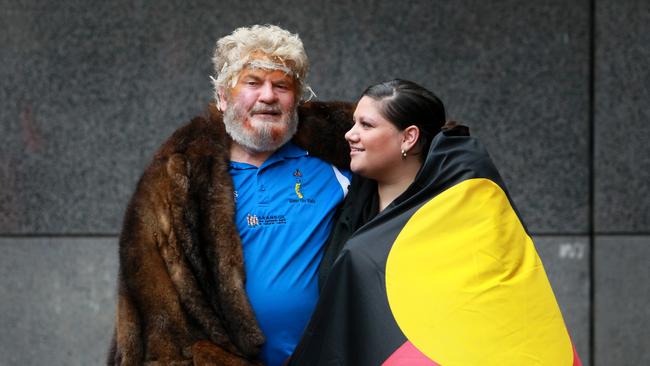There is no question the Indigenous voice to parliament is racially discriminatory
Incompetent ATSIC could be abolished because it was created by legislation; the voice, once it is entrenched in the Constitution, will be there for generations to come.

Writing in last weekend’s Inquirer, Chris Kenny made a number of assertions about the voice that deserve closer scrutiny.
Kenny recognises the intellectual merit of the “philosophical objection to separating citizens or awarding certain rights according to race (which) flows from the liberalist ideal about all citizens being equal under the law”. He goes on to claim, however, that any discrimination the voice might entail would be based not on race but on descent.
Why Kenny believes allocating unequal rights on the basis of descent – as in hereditary aristocracy and serfdom – is less offensive than doing so on the basis of race is left unexplained.
But even putting that aside, the reality is that every one of the policies targeted at Indigenous communities that Kenny lists – from subsidies to measures to curb substance abuse – was enacted under the Constitution’s race power, not under an inexistent power to discriminate on the basis of descent.
And when challenges were mounted to those policies’ eligibility restrictions, the courts found that they were indeed racially discriminatory but upheld them because the Constitution allows parliament to discriminate on the basis of race.
There is, as a result, no question that the voice is racially discriminatory, just as were its predecessors; rather, the real issue is whether the racial discrimination it involves is justified.
Its supporters, including Kenny, contend that it is, arguing that it will bring gains that outweigh any harms. Assessing that claim inevitably requires some conception of how the voice would operate, and what impact its functioning would have not just on Indigenous Australians but on other Australians as well. That makes it difficult to understand why Kenny dismisses concerns about its consequences for the effectiveness of the legislature and of executive government out of hand.
On the contrary, the fact that the Nordic countries, which are usually regarded as models of social inclusiveness, have baulked at granting their Indigenous parliaments (which represent the Sami, or Lap, peoples) the sweeping rights of consultation the voice would enjoy suggests those concerns should be taken seriously.
But the damage the voice may cause goes well beyond the machinery of government. In effect, if there is a lesson to be drawn from its predecessors – the National Aboriginal Consultative Committee (1973-77), the National Aboriginal Conference (1977-85) and the Aboriginal and Torres Strait Islander Commission (1990-2005) – it is that they all led to a prolonged deterioration in race relations.
Nor is that surprising. It is a staple of political science that the structure of political institutions is never innocent or inconsequential. That is because political representation does not passively reflect underlying cleavages in the population; rather, it gives them form, creating incentives for political entrepreneurs to exploit the differences they reflect. As those entrepreneurs advance claims on behalf of the group they purport to represent, they naturally emphasise what the group has in common and what there is that sets it apart.
The great 19th century political theorists recognised that logic’s implications: the broader and more diverse the constituency, the greater the degree to which competing candidates will have to appeal to issues and interests that transcend sectional boundaries; conversely, when representation is narrowly defined, political elites will use the rhetoric of friend and foe to accentuate the group’s sense of identity while casting the rest of the population as its adversary.
Moreover, the narrower the group, the lower the likelihood that it will bear the costs of the demands it advances – and hence the greater the risk that separate representation will unleash a torrent of costly demands, impoverishing the nation and stoking the flames of resentment.
Thus, create a body representing Indigenous Australians, and them alone, and political entrepreneurs will emphasise what distinguishes Indigenous Australians from other Australians, not least by demonising a common enemy. The result will be radicalisation rather than reconciliation, deepening racial fractures and strengthening separatist pressures.
And to make things worse, the very fact of dividing the population on the basis of race in the Constitution, the nation’s foundational document, will endorse the notion that there are essential, immutable differences between Indigenous and non-Indigenous Australians, with the conflicts separate representation invariably generates giving that inherently abhorrent, artificially cemented, colour line even starker salience.
It is therefore no accident that the National Aboriginal Conference degenerated into an unending confrontation with the Fraser government and then that of Bob Hawke, placing the demand for a treaty that would recognise the undivided sovereignty of an “Indigenous nation” above the practical issues that desperately needed to be addressed.
Nor is it an accident that a careful study of Sweden’s Sami parliament concludes that it has served to “intensify the Sami-state conflict”, with Sami politicians casting “government policy and thus, ultimately, the Swedish state” as their “main adversary”– and the deterioration in the relations between the Sami and the state has been even greater in otherwise consensual Finland.
John Howard was consequently prescient in 1989 when he warned – in comments widely derided as racist – that far from advancing reconciliation, ATSIC would prove “a monumental disservice to the Australian community” which would “strike at the heart of the unity of the Australian people”. But ATSIC – whose main novelty lay in adding cronyism and incompetence to its predecessors’ intransigence – could be abolished (with bipartisan support) because it was created by legislation; the voice, once it is entrenched in the Constitution, will be there for generations to come.
That would not be a pity; it would be a tragedy. The reality is that the vast majority of Australians share the positive vision Paul Hasluck, Robert Menzies’ long-serving minister for territories, forcefully set out in 1961. Indigenous Australians, he told the state premiers, deserve to be “members of a single Australian community enjoying the same rights, privileges and obligations as other Australians”, with any special measures being “temporary measures” that would “assist them to make the transition”.
Never was that emphasis on equal, rather than special, rights clearer than in the 1967 referendum. Kenny grievously mischaracterises that referendum as an endorsement of separatism; it was, in fact, its exact opposite.
From one end of the country to the other, a song rang out as a clarion call: “‘Vote Yes’”, it urged, “to give (Aborigines) rights just like me and you”. And when Faith Bandler – who came to embody the campaign’s spirit – famously crystallised what was at stake, she said, unforgettably and unambiguously, that “the original Australians” no longer wanted to be “a race apart in the land of their birth”: they wanted to be “treated equally with other Australians”.
Indeed, the demand on the Indigenous petition that marked the campaign’s origin was not for the proposition that was eventually put to the Australian people – that is, an amendment extending to Aborigines the commonwealth’s power to make laws for any “race”. It was for the deletion from the Constitution of all reference to race, cleansing our founding document of the stain that had tarred it from birth.
Unfortunately, that plea was overruled by the campaign’s non-Indigenous advisers, who claimed special laws, passed using the race power, would eradicate Aboriginal poverty and hardship. Now, after decades of failure that should have shattered that illusion, we are once again being told that constitutionalising inequality will promote equality and that enshrining separateness will reinforce national unity.
It is surely time that illusion, which has trapped so many Indigenous communities in chronic disadvantage, endemic violence and spiralling rates of incarceration, was abandoned once and for all.
Instead, what needs to be rekindled is the spirit of political equality that Bandler so powerfully evoked years ago. It remains what most Australians believe. It is consistent with this country’s most cherished values. And now as then, it is what we owe the Australians of the future, of all colours and creeds, who will inherit the Australia we make.




To join the conversation, please log in. Don't have an account? Register
Join the conversation, you are commenting as Logout